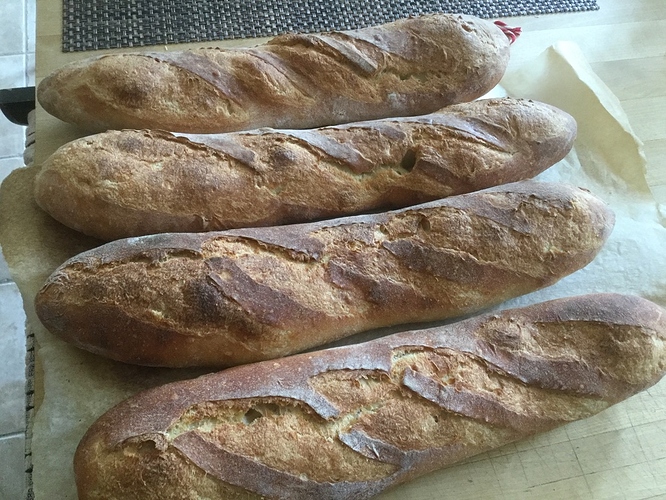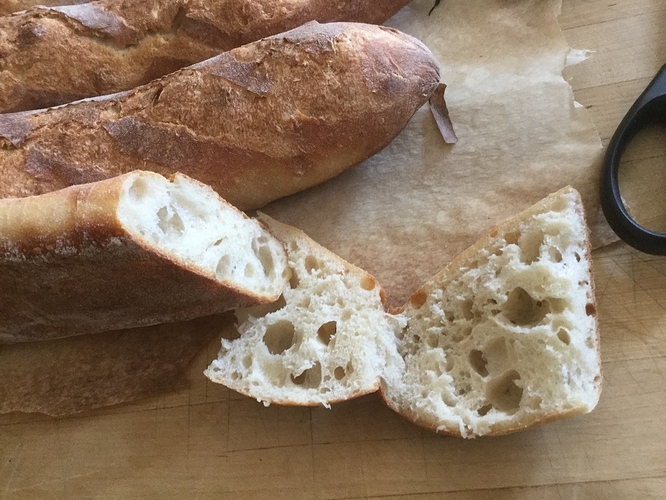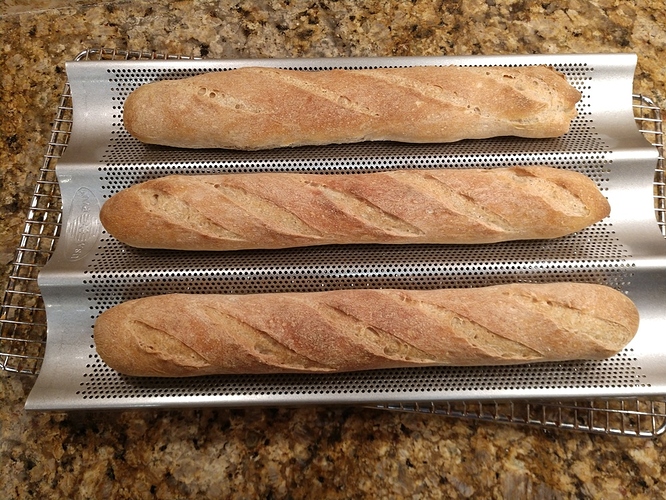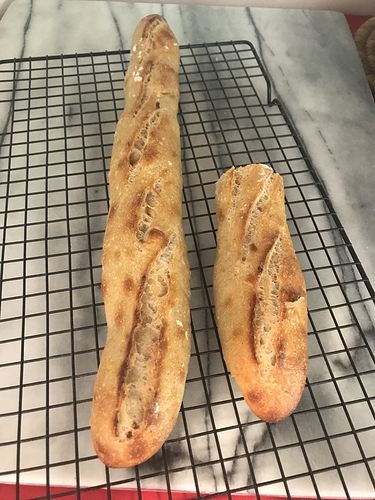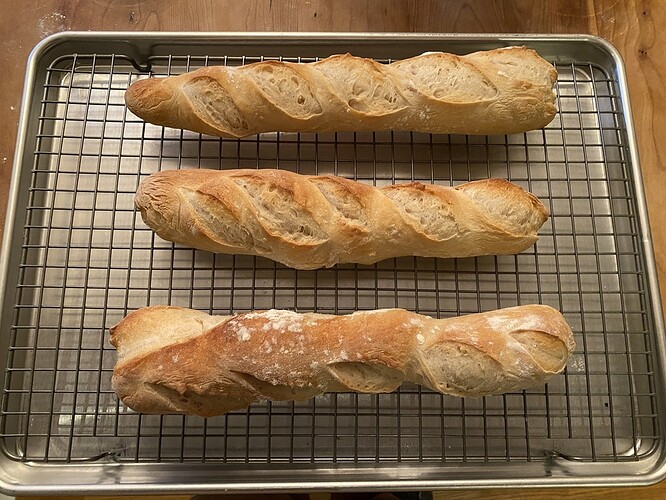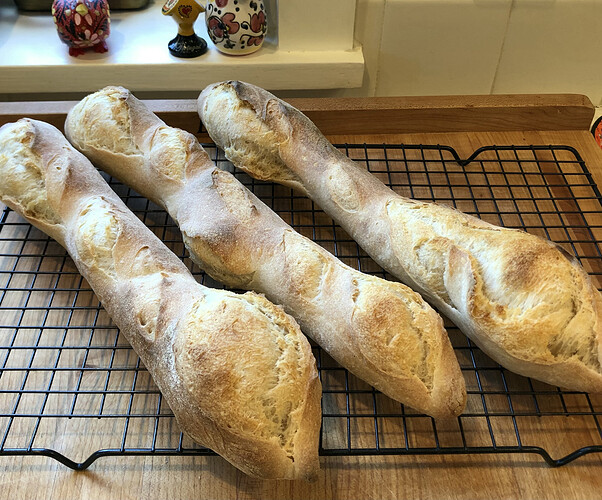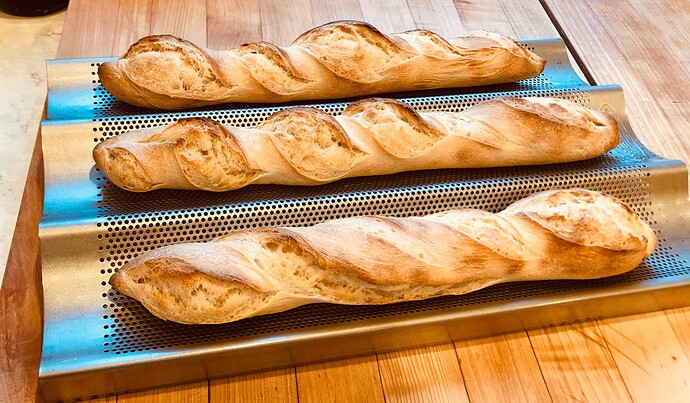First ever bread making attempt. I used a 70% total hydration and baked in our Forno Toscano wood-fried oven.
Turned out awesome. Thanks for the video techniques. particularly the proofing linen (I used some cheesecloth I had around) and the flipping board ( I used a hunka cardboard ).
I don’t have a baking stone, nor do I have a baguette pan. What can I substitute? Also thanks to Suzanne who transcribed the instructions! I also do better with written instructions that I can print and not worry about getting dough all over it!
Upside down baking sheet. If non-stick, don’t go past 450F.
I tested pizzas this way vs. a stone and the bake time was a bit longer but otherwise a good outcome.
Love my new baguette pan from Breadtopia! Also, in Eric’s recipe, I just start on Day 2, substituting 250g sourdough starter for the overnight poolish, and the result is very nice. It’s also a quick recipe whenever you find yourself with too much starter : )
I have twice now made yeasted baguettes, but finally tried a sourdough version—no additional yeast added. As with the previous batches, my scoring could use some work, but these were the bomb. I lived in the Bay Area for 8 years back in the 90s and became rather accustomed to delicious sourdough baguettes— so much so it was a shock when I moved East and could no longer get real sourdough baguettes. The batch I baked today are of Bay Area quality, in my humble opinion. I made a sourdough levain Wednesday evening, the final dough Thursday late morning, then since it was bulk fermenting slowly I stuck it in the fridge overnight. Preshaped, shaped, and proofed this morning, baked the loaves around 10:30 am.
Awesome! Those look like they have a perfect texture.
Sadly they are all gone.  Time to bake some more!
Time to bake some more!
I’ confused with the substitution of sourdough starter. Do you add 1/4 cup (125g) of sourdough starter (for the 1g of instant yeast) into the 125g water and 125g of flour for the overnight poolish; then add another 125g sourdough starter (substituting for the yeast) the next morning? Or can you just add 250g starter into the morning mix and skip the overnight poolish? If you can skip the overnight poolish, do you need to add the water (1/2 cup) and flour (1 cup) from the night before?
Hi, before I begin, can you substitute bread flour for all purpose flour or is that not a good thing to do? Thanks!
Shermaine
If the question is: Can you use regular all purpose flour in place of bread flour, the answer is maybe. The point of using bread flour in bread making is that it contains a much higher gluten content, which is the protein that gives bread its texture and chewiness, and gives it the elasticity to stretch to support the gas bubbles produced by yeast. Regular AP flour lacks that extra protein. You can get away with using it if you add vital wheat gluten (Bob’s red mill has some, and Breadtopia may as well) according to the package directions. This boosts the protein content of the flour and lets it behave more like a true bread flour. However, AP flour even with vital wheat gluten is not identical in properties to bread flour. Even a high(er) gluten AP flour is not going to have the strength to produce the highly leavened and structured bread you think of when you think of artisan breads. Vital wheat gluten helps offset that deficit, but there are other properties that set bread flour apart from AP. So for best results, use bread flour for bread baking, at least where sourdough or artisan loafs are the desired end product. Regular AP flour is fine for sandwich breads, since the dough is supported by the pan you bake them in while most artisan breads are baked in a cloche or other covered vessel, on a baking stone, or in a steam oven without a pan. I hope that helps.
I’m wondering why this recipe uses AP flour as opposed to Bread flour. How would using Bread flour instead change it?
Hi Valerie, I’m not the author of this recipe, but I wrote a blog post about baguettes Poppyseed Crusted Yorkville Sourdough Baguettes | Breadtopia One of the challenges of baguettes is the dough having the extensibility to stretch it out when doing final shaping. After a lot, I mean a lot of baking this past summer, I came to the conclusion that our Canadian bread flour is far too elastic for my shaping skills. I came to the conclusion that using AP flour had some advantages including being less elastic and more extensible than bread flour. As well, another characteristic many love about baguettes is having a thin crisp crust. Lower protein flours tend to bake up with a thinner crust.
Thank you Benito! Very helpful. I’m used to baking sourdough batards with ancient grains, so baguettes are a whole new thing for me. I tried a batch yesterday following the recipe as written, and they weren’t bad for a first attempt. Today I’m trying a sourdough batch with a 75% hydration. We will see…
I’ve been getting some tasty results with this, but my baguettes are coming out very “shapely”. Is this most likely from my shaping technique, or from my scoring technique? The loaves look normal after shaping and resting.
@pketro @jvalerie The challenge of baguettes is that little errors get magnified as the process goes on. Have a look at my article Poppyseed Crusted Yorkville Sourdough Baguettes | Breadtopia I’ve posted videos on shaping and scoring you might find helpful.
@jvalerie I see a couple of issues affecting your baguettes. I wonder if the seam wasn’t on the bottom when you baked those baguettes. I see blow outs on the sides. The other issue is shaping related with the ends of the baguettes being shaped thicker than the middles. When you’re rolling out use mostly gentle downward pressure while rolling and keep rolling as you’re pressing. The downward pressure as you move outwards will stretch the dough but if you press too hard you’ll cause thin areas. Mostly it just requires a lot of practice. I certainly still have issues at times too.
Benny
@Benito Thank you! My loaves looked and felt even when I shaped them, and after proofing, but I suppose maybe they weren’t. Not sure where the seam was, as I lose track of it when I roll out the baguettes. Much easier to see on a regular boule or batard! I will keep at it.
When rolling and stretching my baguette dough, I place it seam side down since that side is the least floured and roll them in that orientation. Then move to the couche seam side up. After the resting proofing time transfer to the transfer board, it will be seam side down, side or pop it off to the peel seam side down. It’s so important never to lose sight of that seam with baguettes.
@Benito Thanks for all the tips! My loaves are getting better, but I’m still having a hard time keeping track of the seam sometimes…
@jvalerie definitely improving. If you shape seam side down and when rolling to stretch, remember you don’t need to roll very much in either direction, you should be able to find the seam. Yes keeping an eye on the seam is really essential when baking baguettes to avoid blow outs.
